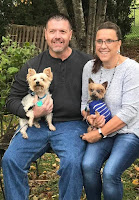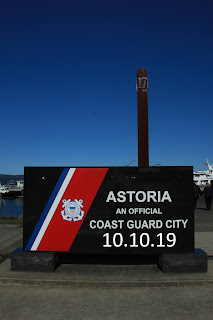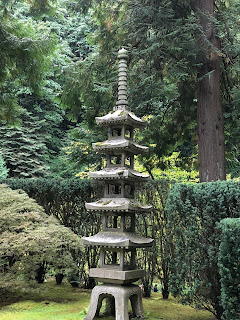Volume XLVI December
25, 2019
Christmas
2019
Dear friends,
Each year I seem to
begin with “I can’t believe that I have been writing this Christmas Epistle for
such and such a number years. Writing
Roman numerals this large is getting to be a challenge. I hope XLVI is correct for 46. Another challenge is finding something
amusing or entertaining to say about the state of our world at present. I guess I will settle for a strange
congruence since I wrote the first of these letters in 1973 and Watergate was
an item mentioned. It was sad then and remains sad now. So here’s my funny for
2019. Bozone ( n.): The substance surrounding
people that stops facts from penetrating. The Bozone layer, unfortunately,
shows little sign of breaking down in the near future.
 Now down to what’s what for this past year. Jim and Jan still do most things together. We
work at the Warren
County History Museum, we support the Friends of the Library, we attend meetings of the Warren County
Democrats, we shop together, share the
cooking, and read widely and avidly. Jan
is a life member of the American Association of University Women and spends
mucho time on Equal Pay, Voter registration, and STEM projects. If she hadn’t taken a tumble on the way to the
Monmouth College Christmas Concert the other night and sprained her wrist, the entire year would have
been hunky dory.
Now down to what’s what for this past year. Jim and Jan still do most things together. We
work at the Warren
County History Museum, we support the Friends of the Library, we attend meetings of the Warren County
Democrats, we shop together, share the
cooking, and read widely and avidly. Jan
is a life member of the American Association of University Women and spends
mucho time on Equal Pay, Voter registration, and STEM projects. If she hadn’t taken a tumble on the way to the
Monmouth College Christmas Concert the other night and sprained her wrist, the entire year would have
been hunky dory.
Jim continues to try
to keep up with the theatre scene, write in his blog, and work with Rotary. He has found a new to him detective series by
Louise Penny and has been trying to read all the earlier ones. Two major projects
this year have been organizing an open house for our 60th (can you believe it) wedding anniversary and taking a Road Scholar Small Ship Lewis and
Clark cruise on the Columbia River. You
can read more about our trip and see pictures right here on the blog. Look in the archive of posts on the right and open Novembr. From there you can find post number 1 and go through the whole trip. Monmouth is still our home, but we did also
manage a three month getaway to Tucson last winter. With a bit of luck we shall head back to the
Southwest shortly after Christmas.
Break time for a theatre funny: “ If the police arrest a mime, do they tell
him he has the right to remain silent?”
 Meanwhile, in a galaxy far far away, the Helsinki Finns (son David daughter-in-law Lotta, and our two
granddaughters Frida and Selma) continue
their life abroad. We saw David briefly in Minneapolis last
summer, but have not seen Lotta and the girls for over a year. Both the young ones are growing like weeds.
Frida is 7 and is now in school.
She is taking music lessons and has just passed her first swimming test. Selma
is 4 and goes to what the Finns call
Paivakotti. She loves to dance
and sing and draw.
Meanwhile, in a galaxy far far away, the Helsinki Finns (son David daughter-in-law Lotta, and our two
granddaughters Frida and Selma) continue
their life abroad. We saw David briefly in Minneapolis last
summer, but have not seen Lotta and the girls for over a year. Both the young ones are growing like weeds.
Frida is 7 and is now in school.
She is taking music lessons and has just passed her first swimming test. Selma
is 4 and goes to what the Finns call
Paivakotti. She loves to dance
and sing and draw.
We are looking
forward to a visit from all of them in Tucson in February. Lotta continues her therapy practice and
David continues to work for the Kone Elevator company, which was mentioned in a
recent article about life in Finland in the New
York Times. He will also be
participating in a low-residency New
York University MFA program in poetry beginning
in January.
Time for another intermission: Did you know that the term “piker” meaning
cheapskate or cheater grew out
of people who tried to evade the cost when they came up to a pay station on the
first toll roads?
 Back to business. The Brown family of Amy, Todd, Taylor, and
Mikel all still hang out in Iowa. Todd, on the left, had had a good year until two herniated disks put him in the hospital for
emergency back surgery. Up to that time
he had been given more supervisory duties at his work, went on a major fishing
trip with friends that netted the family and us some delicious salmon fillets,
and rode his Harley to the Sturgis SD
Motorcycle Rally. Amy, on the right) remains the
caregiver for all humanity and she has had a workout this year with Todd’s
back, Jan’s fall, and various friends with problems. School for her this year
has blessedly been an upper as she has a smaller and better class. She is also taking a couple of continuing
education classes to keep her certification up to snuff.
Back to business. The Brown family of Amy, Todd, Taylor, and
Mikel all still hang out in Iowa. Todd, on the left, had had a good year until two herniated disks put him in the hospital for
emergency back surgery. Up to that time
he had been given more supervisory duties at his work, went on a major fishing
trip with friends that netted the family and us some delicious salmon fillets,
and rode his Harley to the Sturgis SD
Motorcycle Rally. Amy, on the right) remains the
caregiver for all humanity and she has had a workout this year with Todd’s
back, Jan’s fall, and various friends with problems. School for her this year
has blessedly been an upper as she has a smaller and better class. She is also taking a couple of continuing
education classes to keep her certification up to snuff.
Grandson Mikel,on the right, is a senior in High School and
will be doing his final year of baseball this spring
and summer. He is still working part-time at the Play Station and somehow he and Mom
and Dad have also been doing the
“looking at colleges” dance. Mikel’s
current interest is in the wildlife and environmental management area. I think
he would make a wonderful park ranger. Grandson Taylor, on the left, has finished his
formal education for now and is working full time as a nationally certified
Paramedic in a small town near Des Moines, while
also doing some hours with some old friends at the Hiawatha, IA, fire and rescue department. He is a busy young
man with a crazy schedule. The picture was taken at a Cubs Spring Training game
last March.
For my final funny of the year let’s ask this question. Why do they lock gas station bathrooms? Are they afraid someone will clean them?
Thanks once again for reading our letter this year and for
many of you over many years. May you find
great joy and blessings in the promise of this Christmas Season even in these
troubled times. Think about keeping only
cheerful friends; grouches tend to pull you down to their level.
Merry Christmas and Happy New Year!
Jim and Jan De Young









































































